The Ultrasonic Homogenizer Machines Market is estimated to be valued at USD 657.4 million in 2025 and is projected to reach USD 1,472.8 million by 2035, registering a compound annual growth rate (CAGR) of 8.4% over the forecast period.
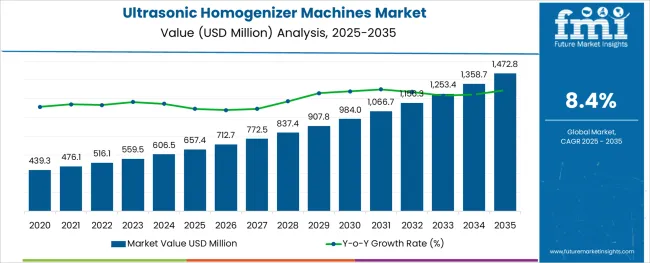
The ultrasonic homogenizer machines market is experiencing progressive growth driven by advancements in laboratory automation, rising demand for high-precision sample preparation, and increasing adoption in biotechnology and pharmaceutical research. Manufacturers are responding to the need for consistent and efficient homogenization processes by introducing machines with enhanced power control, noise reduction, and digital monitoring capabilities.
The market is benefiting from the trend of miniaturization and the focus on reproducibility in laboratory workflows. Future opportunities are anticipated as more applications emerge in drug discovery, nanomaterials research, and environmental testing.
Growth is further supported by stricter quality standards, rising investments in life sciences, and the shift towards eco-friendly, energy-efficient technologies that reduce operational costs and enhance laboratory sustainability. Strategic collaborations between manufacturers and research institutions are expected to pave the way for innovations and broader adoption in diverse research environments.
The market is segmented by Product Type, End Use Application, Valve Technology, Modality, and Automation and region. By Product Type, the market is divided into Bench Ultrasonic Homogenizers, Cell Disruptor, DNA and Chromatin Shearing System, and Industrial-Scale Ultrasonic Homogenizers.
In terms of End Use Application, the market is classified into Biotech Laboratories, Dairy and Food Industry, Pharmaceuticals Industry, Research Laboratories, NanoParticle Formation, Chemical Industry, and Others. Based on Valve Technology, the market is segmented into Single-Valve Assembly and Two-Valve Assembly. By Modality, the market is divided into Bench-top and Hand-held.
By Automation, the market is segmented into Automatic and Semi-Automatic. Regionally, the market is classified into North America, Latin America, Western Europe, Eastern Europe, Balkan & Baltic Countries, Russia & Belarus, Central Asia, East Asia, South Asia & Pacific, and the Middle East & Africa.
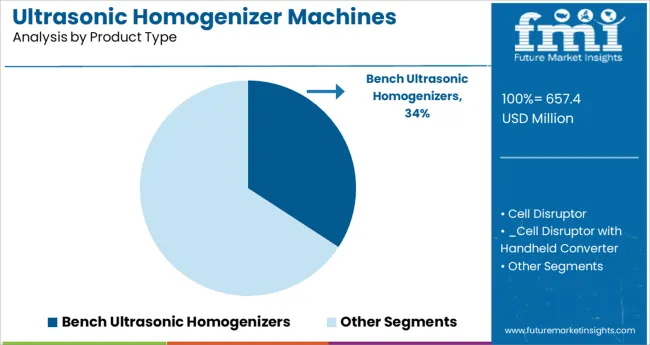
When segmented by product type, bench ultrasonic homogenizers are projected to hold 34.2% of the total market revenue in 2025, establishing themselves as the leading product category. This leadership is being driven by their versatility, compact design, and ability to deliver high-intensity ultrasonic energy in controlled environments.
Their dominance is reinforced by suitability for small to medium-scale applications where space constraints and precision are critical. Bench models have been preferred in academic and industrial laboratories owing to their ease of integration, user-friendly interfaces, and lower maintenance requirements compared to larger industrial units.
Enhanced features such as programmable settings, digital displays, and noise insulation have further strengthened their position. The ability to efficiently handle a broad range of sample types while ensuring reproducibility and minimizing operator fatigue has contributed significantly to the sustained preference for bench ultrasonic homogenizers in laboratory settings.
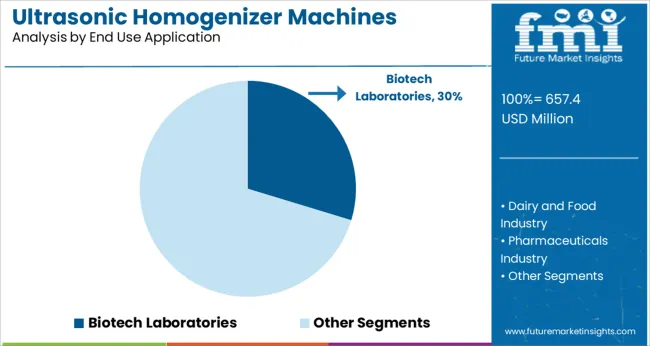
Segmenting by end use application, biotech laboratories are expected to account for 29.7% of the ultrasonic homogenizer machines market revenue in 2025, affirming their position as the top application area. This prominence is being fueled by the expanding scope of biotechnological research and development, where precise sample disruption and cell lysis are essential.
Biotech laboratories have increasingly adopted ultrasonic homogenizers to achieve higher yield and purity of biomolecules without compromising structural integrity. Their leadership is supported by growing investments in genomics, proteomics, and cellular research, which demand reliable and scalable homogenization technologies.
The need to process delicate biological materials efficiently while maintaining contamination control has reinforced the reliance on ultrasonic homogenizers. Additionally, the growing emphasis on personalized medicine and high-throughput screening has created a sustained demand for advanced, compact machines tailored to the specific needs of biotechnological research environments.

When segmented by valve technology, single valve assembly is projected to capture 61.5% of the market revenue in 2025, asserting its leadership among the available technologies. This segment’s strength is being driven by its simplicity, reliability, and cost-effectiveness, which have made it the preferred choice in laboratory and pilot-scale operations.
The streamlined design of single valve assemblies facilitates easy maintenance and reduces the risk of operational failures, ensuring consistent performance over prolonged usage. Their dominance has also been supported by advancements in manufacturing that have improved their durability and compatibility with a wide range of sample viscosities.
Laboratories have favored this technology for its ability to deliver precise control of ultrasonic energy while minimizing energy losses and mechanical wear. The widespread acceptance of single valve assemblies as a robust and efficient solution has reinforced their continued prevalence in both routine and advanced ultrasonic homogenization processes.
The global ultrasonic homogenizer machines market is expected to grow at a steady pace in the forecast period because of the increasing demand for convenience meals and beverage products.
Apart from that, the increasing adoption of busy lifestyles by consumers and surging demand for cosmetics & private care products are projected to augur well for the global market from 2025 to 2035.
Growing investments by key companies in new product developments is another crucial factor that would drive the global market. From moving to deliver chains to fee savings, automation, and consumer focus, the market is likely to witness rapid development. The ultrasonic homogenizer machines market is projected to create new opportunities for businesses operating across the globe.
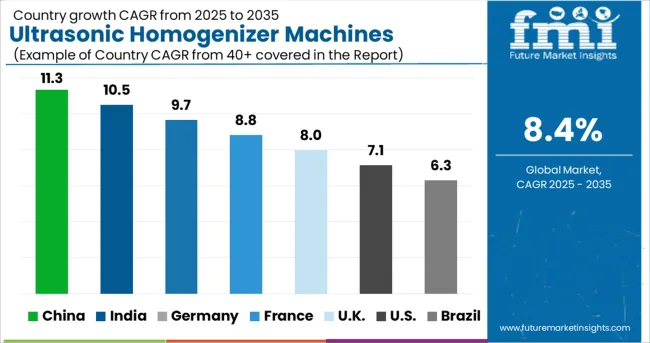
Investments in Research Activities to Drive the Need for High-Pressure Homogenizers in the UK
The UK is estimated to hold its dominant position in the Europe ultrasonic homogenizer machines market by the end of 2035. Growth is mainly attributed to the ongoing development of a wide variety of meals and dairy products.
The emergence of various laboratories and rising investments in research studies are also anticipated to propel the UK ultrasonic homogenizer market over the forecast period.
As per FMI, the Europe ultrasonic homogenizer machines market is projected to grow at 32% CAGR between 2025 and 2035. The increasing need for advanced ultrasonic homogenizer software solutions for emulsified diesel gas oil production is also expected to aid growth.
Surging Demand for Medicines in the USA to Push Sales of High-Speed Homogenizers
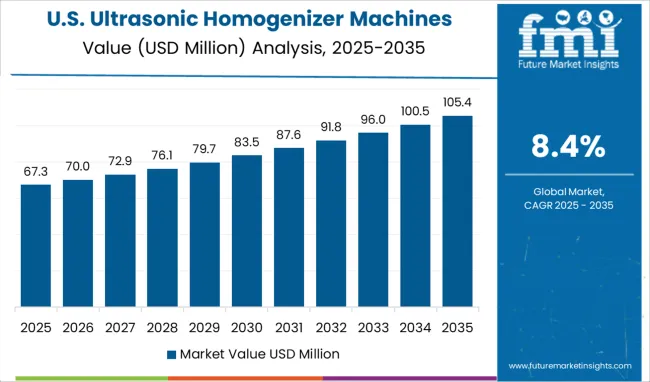
The ultrasonic homogenizer machines market in the USA is expected to grow at a CAGR of 68% from 2025 to 2035. The rapid expansion of the pharmaceutical industry in the country is mainly set to drive the market in the assessment period.
As per Statista, the total amount of money spent on medicines reached nearly USD 606.5 Billion in 2024 in the USA alone. The number is set to surge at a fast pace in the country with the rising prevalence of diabetes, obesity, and cancer, thereby pushing the market.
Ongoing Development of Drugs in India to Foster Sales of Emulsifier Machines by 2035
The rapid expansion of the pharmaceutical and cosmetics industries is projected to push the India ultrasonic homogenizer machines market by the end of 2035.
As per the India Brand Equity Foundation (IBEF), the country’s pharmaceutical sector delivers more than 50% of the global demand for various vaccines, 25% of all medicine in the UK, and 40% of generic demand in the USA
Also, the domestic pharmaceutical industry contains approximately 10,500 manufacturing units and a network of 3,000 drug companies. Owing to the aforementioned factors, ultrasonic homogenizer machines are projected to be extensively used in the Indian pharmaceutical sector during the evaluation period.
High Demand for Packed Meals in China to Fuel Sales of Homogenizer Equipment
In Asia Pacific, China is set to become a leading country in the ultrasonic homogenizer machines market during the forecast period owing to the presence of a well-established pharmaceutical industry. Besides, the increasing population, rising investments in healthcare, and growing prevalence of chronic diseases are set to propel the market in China.
Also, the high demand for processed and packed meals, especially among the working and millennial populations, is likely to aid the China market.
Demand for Milk Homogenizer Machines to Surge across the Globe
Growing demand for ultrasonic homogenizer machines for small vessel places accompanying excessive power for diverse methods, which includes DNA shearing and others, are predicted to push the global market over the forecast period.
A growing number of food and dairy enterprises with technological improvements are also predicted to propel the ultrasonic homogenizer machines market throughout the globe.
Ultrasonic homogenization can complete various functions like dispersing, mixing, extraction, chemical response, and length elimination for businesses, in addition to laboratory functions. While ultrasonic batch homogenizers can be used for laboratory functions, non-stop ultrasonic homogenizers are used for business functions.
In the dairy industry, on the other hand, ultrasonic homogenizer machines are used to postpone or prevent the formation of a cream layer in complete cream milk by reducing the diameter of fat globules. After homogenization, the length of fat globules turns into much less than 2µm. The common length of milk fat globules in milk is 2-12µm.
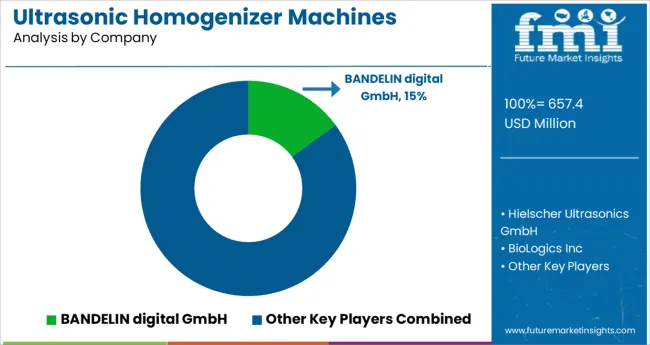
The global ultrasonic homogenizer machines market is highly fragmented and competitive due to the presence of several local and regional companies.
Key players are adopting a wide range of marketing strategies such as partnerships, expansions, mergers & acquisitions, and collaborations to strengthen their positions in the global market.
Some of the renowned companies operating in the global ultrasonic homogenizer machines market are BANDELIN Digital GmbH & Co. KG Hielscher Ultrasonics GmbH, BioLogics Inc.
OMNI International, Pro Scientific INC., Sonic Corporation, Topas GmbH, Emerson Industrial Automation, Bandelin, Fisher Scientific, Frontline Electronics and Machinery Private Limited, Qsonica, Industrial Sonomechanics (ISM), and PolyScience among others.
For instance,
PRO Scientific Inc., Sonic Corporation, and Topas GmbH Offer Customized Ultrasonic Homogenizer Machines with Constant Innovation
Ultrasonic homogenizers are being used by companies in different ways. Pro Scientific is one of the leading companies that is utilizing ultrasonic homogenizer machines to mix ingredients for its food products.
These machines are helping the company to produce fast, high-quality results with minimal agitation or surface contact. Some of the significant benefits of this type of mixing are that it produces a very uniform product without any stratification, which saves time during production.
PRO Scientific Inc. is a global pioneer in the designing and manufacturing of high-quality homogenizing, mixing, shaking, stirring, and centrifuging equipment. PRO Scientific homogenizers have been the market leader in sub-cellular analysis and high-volume applications for almost two decades.
The company has been able to stay in contact with and respond to the needs of the homogenizer market through its network of national sales agents and distributors. In addition to a full line of homogenizers, PRO Scientific proudly offers the Lab Plus Series of mixing, shaking, and stirring equipment.
Since 2020, the product offering has expanded to include a unique Maxi-jet system and a new line of standard jet systems. The company continues to innovate and develop new technologies and products.
Recently, it announced a partnership with Topas GmbH for the manufacturing of ultrasonic homogenizers for industrial applications, especially for use in animal feed production.
They also recently introduced a new range of labware, which includes new functionalities such as a more powerful liquid introduction at variable pressure and automatic opening doors.
Sonic Corporation is a Stratford, Connecticut-based equipment manufacturer that designs and manufactures homogenizers, blending systems, process skids, colloid mills, chemical metering skids, and other products.
The company creates a patented homogenizer known as the Sonolator, which is utilized in the chemical, beverage, and personal care sectors for emulsifying and dispersing fluids.
Custom high-pressure homogenizer systems are designed to deliver process benefits such as multiple-feed metering, in-line continuous & semi-continuous mixing, enhanced particle sizes, cycle time savings, and labor reduction. Sonic also produces Colloid Mills and Grinding Mill systems for the chemical sector, which are used to handle lubricants, greases, clays, and bentonite.
In 2020, Sonic Corporation introduced a new generation of ultrasonic homogenizers. The company also launched a new line of products, which includes its first-ever continuous flow device.
The new ultrasonic homogenizer is designed to make it easier to produce large batches of soft foods. It offers greater production flexibility with higher capacity and added versatility that can be customized for specialized applications such as mixing, blending, or pureeing.
Additionally, Topas is the industry leader in the development of complicated test systems for filters, filter media, separators, and liquid filters. Topas is best known for providing high-quality goods and pioneering efforts in particle and aerosol technologies since 1991.
As designers and producers of test equipment for the creation, measurement, and dilution of suspended particles, the company provides ideas and experiences to clients from all over the world. Topas GmbH's corporate strategy enables rapid response to current market developments and fulfillment of client requests.
Recently, it has been developing its product offering through innovation. For instance, the company announced that it has partnered up with GE Healthcare to develop new ultrasound imaging technologies for use in advanced healthcare diagnostics.
With this partnership, they would be able to bring new innovations into ultrasound diagnosis while also using their expertise in the design of high-performance ultrasound probes. In order to stay competitive worldwide, these companies will have to continue expanding their offerings and innovating so that they can stay at the forefront.
| Attribute | Details |
|---|---|
| Estimated Market Size (2025) | USD 559.5 Million |
| Projected Market Valuation (2035) | USD 1,253.4 Million |
| Value-based CAGR (2025 to 2035) | 8.4% |
| Forecast Period | 2025 to 2035 |
| Historical Data Available for | 2020 to 2024 |
| Market Analysis | Value (USD Million) |
| Key Countries Covered | USA, UK, China, India, Japan, South Korea, Canada, Brazil, Mexico, Argentina, Germany, Spain, Russia, Poland, Nordics, Australia, New Zealand, Thailand, Indonesia |
| Key Segments Covered | Product Type, Automation, Valve Technology, Modality, Application, Region |
| Key Companies Profiled | BANDELIN digital GmbH; Co. KG Hielscher Ultrasonics GmbH; BioLogics Inc.; OMNI International; Pro Scientific INC.; Sonic Corporation; Topas GmbH; Emerson Industrial Automation; Bandelin; Fisher Scientific; Frontline Electronics; Machinery Private Limited; Qsonica; Industrial Sonomechanics (ISM); PolyScience; VELP Scientifica; Stuart Equipment; Biobase; Interscience; Microtec Co., Ltd.; Cole-Parmer; Metrohm; BIo-Rad; Alliance Bio Expertise; GEA Tiromat Packaging; Eberbach Corporation; GeneReach; Tomtec; Scilogex; Bandelin Electronic; Bertin Technologies; Hercuvan; PRO Scientific Inc.; Analytik Jena |
| Report Coverage | Market Forecast, Company Share Analysis, Competitive Landscape, Drivers, Restraints, Opportunities and Threats Analysis, Market Dynamics and Challenges, and Strategic Growth Initiatives |
The global ultrasonic homogenizer machines market is estimated to be valued at USD 657.4 million in 2025.
It is projected to reach USD 1,472.8 million by 2035.
The market is expected to grow at a 8.4% CAGR between 2025 and 2035.
The key product types are bench ultrasonic homogenizers, cell disruptor, _cell disruptor with handheld converter, _cell disruptor with traditional converter, dna and chromatin shearing system and industrial-scale ultrasonic homogenizers.
biotech laboratories segment is expected to dominate with a 29.7% industry share in 2025.






Full Research Suite comprises of:
Market outlook & trends analysis
Interviews & case studies
Strategic recommendations
Vendor profiles & capabilities analysis
5-year forecasts
8 regions and 60+ country-level data splits
Market segment data splits
12 months of continuous data updates
DELIVERED AS:
PDF EXCEL ONLINE
Ultrasonic Jewelry Cleaning Machine Market Size and Share Forecast Outlook 2025 to 2035
Ultrasonic NDT Equipment Market Size and Share Forecast Outlook 2025 to 2035
Ultrasonic Air Bubble Detectors Market Size and Share Forecast Outlook 2025 to 2035
Ultrasonic Pouch Sealers Market Analysis Size and Share Forecast Outlook 2025 to 2035
Ultrasonic Electrosurgical Devices Market Size and Share Forecast Outlook 2025 to 2035
Ultrasonic Sensors Market Size and Share Forecast Outlook 2025 to 2035
Ultrasonic Cleaning Market Analysis - Size, Growth, and Forecast 2025 to 2035
Ultrasonic Flaw Detector Market – Trends & Forecast 2025 to 2035
Ultrasonic Flowmeters Market Trends – Growth & Forecast 2025 to 2035
Ultrasonic Pulse Velocity Tester Market Growth – Trends & Forecast 2018-2027
Ultrasonic Surgical Cutters Market
Ultrasonic Diathermy Market
Ultrasonic Testing Market
Ultrasonic Technology Market
Ultrasonic Tissue Ablation System Market
Ultrasonic Flow Meter Market
Ultrasonic Dissection Devices Market
Ultrasonic Sealing Machines Market Size and Share Forecast Outlook 2025 to 2035
Dual Frequency Ultrasonic Cleaner Market Size and Share Forecast Outlook 2025 to 2035
Dental Piezoelectric Ultrasonic Unit Market Trends and Forecast 2025 to 2035

Thank you!
You will receive an email from our Business Development Manager. Please be sure to check your SPAM/JUNK folder too.
Chat With
MaRIA